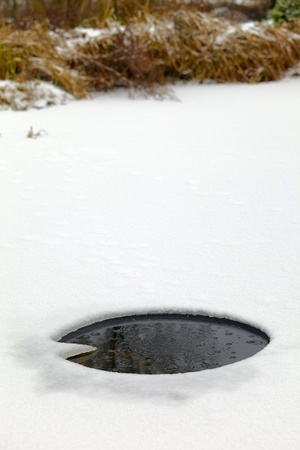Koi How To's
Overwintering Koi Fish
Koi are poikilothermic (cold-blooded). Their metabolism and temperament are very much dependent on the ambient water temperature. Koi have spent thousands of years adapting to extreme seasonal changes, including sub-freezing temperatures. As hardy as they are however, in cold winters your koi will need help with their environment to keep from freezing.
As the proud owner of a koi pond in an area that can get below freezing during the winter months, you will have done your research as to how to winterize your koi pond. But sometimes best laid plans and equipment can fail. And unprecedented cold snaps do happen.
Not being able to see their koi under ice is an unnerving time for many koi owners. They may not be visible, or very active, but given the right care they will be okay. Which means that you should be well prepared. So what do you do to keep your Living Jewels hale and hearty in the coldest part of the year?
Going Indoors
One obvious option is to have an indoor tank where you can relocate your koi for the coldest months of the year. However, in some instances, it is not a viable option with the available space. Additionally, as your koi continue to grow, the size requirements of the pond will change.
Dealing with the Ice Cap
The good news is that should an ice cap form on your pond, provided the pond is over 30” deep and stocked with the appropriate number of koi for its size, it can actually act as a barrier to some of the harsher conditions.
Some pond experts recommend leaving the ice cap intact and—as long your pond has been properly cleared of organic matter and prepared for the winter—letting nature do her work.
Don’t walk on the ice cap either. If a layer of snow covers the ice, carefully brush it off. This can help expose your remaining aquatic plants to any sunlight, which in turn is helpful in synthesizing oxygen.
Aeration and Holes in the Ice
This can be a necessary part of helping with gaseous exchange in some frozen ponds. It keeps oxygen in the pond while helping harmful gases from waste buildup to bubble out. It also helps to thin the ice above it.
Aerators can be added to those dead zones in your pond to help raise O2 levels where they are low or non-existent. The bubble stream should be consistent but not “boiling.” Your koi don’t need to expend extra energy fighting the current that it creates. Additionally, stirring the warmer water at the bottom will lower temperatures where your koi will spend their time in the winter.
Keep a vigilant eye on the aerator to ensure that it continues to work. Have backups ready in the event that there is a malfunction.
If you are going to create a hole on the surface of your pond, never—repeat, never—chisel or hammer a hole in the ice. The concussion can be fatal to your koi. Instead, use hot water to melt a hole.
Greenhouse Covers
Some enthusiasts (like Bob Passovoy) believe that a greenhouse can be a great way to create a barrier between your pond’s surface and the elements. These covers—ranging from simple constructions to elaborate structures—help to keep the pond debris free and warmer underneath.
Heaters
There are several heaters available that use different sources of power to keep small portions of the pond ice free. Like most equipment used to overwinter a koi pond, there are plusses and minuses to those options (as this article points out).
Heaters generally require larger energy inputs, which can drive up costs. For this reason, some enthusiasts avoid them altogether, while others will use an aerator and heater in conjunction.
Regardless of season, Next Day Koi has a wide variety of koi fish for sale. Whether you are a hobbyist or enthusiast, you can choose from our impressive selection of high-quality koi fish. We also offer some of the most competitive Next Day Air shipping rates in the industry to get your next Living Jewel into your pond as quickly as possible.




